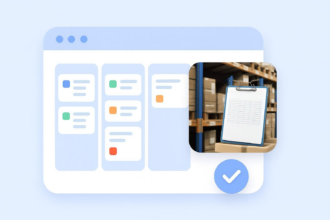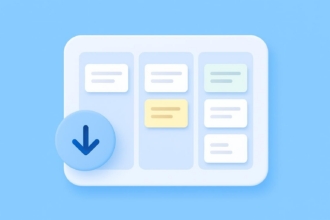If you look into popular production models and productivity tools, you’ll notice kaizen and kanban mentioned together quite often. Both are Japanese words describing lean production techniques popularized by post–World War II manufacturers in Japan. Without knowing their origins and meanings, understanding kaizen vs kanban can be a confusing process.
Here’s the good news: Once you understand them, these productivity tools can be combined to create a more effective workflow.
Kaizen, roughly translating to “change for the better,” describes the philosophy of continuously making small improvements in any kind of system, eventually adding up to big productivity gains. Kanban, on the other hand, means “sign” and describes a method of visualizing the workflow of any delivery system or business.
Kaizen and kanban are not opposing ideas. In fact, they are based on the same productivity principles. In reality, there is no kaizen vs kanban. These tools are best used together, forging a culture of accountability within a project or organization.
Kaizen vs kanban: the origins
After Toyota popularized lean production techniques like kanban and kaizen, the concepts quickly expanded out of manufacturing. Kanban, for example, found a place within any organization that can benefit from a visualized workflow.
To use the kanban system, teams construct easily accessible boards and fill them with cards that represent each deliverable, task, or goal in a project. Those cards are placed within customizable categories arranged either vertically or horizontally on the board. Vertical categories can be status updates, such as “completed” or “in progress.” Horizontal categories are called swimlanes and group similar work together.
In modern workplaces, businesses are adopting digital kanban boards that are accessible from any connected device. With the help of online services, like Jotform Mobile Forms, managers can collect data from team members via automated forms. This data is then inputted directly into a digital kanban board that everyone can see.
Kaizen is a broader principle that can be applied to more than just organizational productivity. With its focus on honest and constant self-improvement, kaizen can apply to an individual’s personal life as well. In fact, healthcare professionals, life coaches, and therapists have incorporated kaizen into their care practices.
Kaizen vs kanban boils down to the former being a philosophy and the latter being a method. Kaizen encourages constant growth while kanban is a practical tool. Together, they can help your team increase productivity.
Kaizen
Every business looking to implement kaizen into their workflow must observe these key points:
Everything in a business or project can be improved
Nothing is safe from analysis and change in a kaizen-based organization. Even the most battle-tested processes should be on the table.
Small changes should be implemented over time to create a culture of regular improvement
Though no task or workflow is sacred within kaizen, changes should still be made incrementally. This way, your workers will have a chance to adapt to each new addition or subtraction to their workflow. Over time, your team can reinvent an entire process without the struggle that comes with sudden change.
Everyone has a say
From the CEO to the most junior employee, each member of a business should be encouraged to offer suggestions that could enhance productivity. Varied perspectives are highly valued in kaizen because they can reveal upgrades that a single manager or leader can’t.
Within kaizen, another focus for workers is to eliminate waste of any kind. In a factory, this could literally mean material waste involved in manufacturing. But in the boardroom, waste can be inefficiencies like redundant meetings. Companies like Google have incorporated kaizen to boost productivity in the past, encouraging programmers and employees to spend 20 percent of their time on company innovation.
How kanban and kaizen work together
You don’t have to choose a side in the kaizen vs kanban discussion — the next step is to figure out how they can work together. The visualized workflow that kanban provides, for example, is a great way to spot areas of growth for kaizen.
When each process is laid out in front of your team, they can use all three of the kaizen principles referenced above. After gaining access to a public kanban board, team members can see how their work interacts within the larger context of the board when making improvements. Additionally, each task in a project is shown on a kanban board, encouraging more incremental changes throughout your workflow — just as kaizen advises.
Tools for introducing a kaizen-based approach
Once you figure out how your company can use kaizen and kanban, you can integrate a number of productivity tools. Services like Trello and Asana include digital kanban board functionality and work well with Jotform’s automated form templates.
With Jotform’s assign forms feature, you can send out regular suggestion forms to your team to help implement growth. To differentiate these forms from everyday paperwork, you can add a little color and class with the designs in the Jotform Theme Store.
Jotform Boards effectively integrates the benefits of the Kanban methodology into your project management process, providing a seamless way to track projects and tasks in real time. Teams can easily create customizable boards, with each task represented by a card that moves across columns to indicate different stages of the workflow. This visual organization helps quickly identify bottlenecks, ensuring no task is left behind and fostering a more transparent and efficient workflow for teams of all sizes.
In addition to Kanban boards, Jotform’s powerful form-building capabilities allow teams to further automate and streamline their workflows. Whether you’re managing support requests, product development, or approval processes, Jotform Boards simplifies task visualization, real-time collaboration, and project tracking. To get started, explore over 1,000 templates that help you streamline your workflow, whether you’re starting from scratch or integrating form submissions.
There’s no need to choose your fighter in the kaizen vs kanban debate. Both are great project management tools for boosting efficiency and productivity.




















Send Comment: